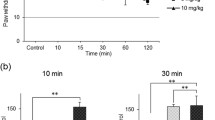Abstract
Purpose
For the suppression of descending inhibitory pathways in animals, single-dose lidocaine blockade is reversible and causes less damage than chronic spinal cord injury, decerebration, and cold blockade of the spinal cord. However, single-dose blockade has a variable onset and is relatively short-lived. To surmount these disadvantages, we devised a continuous thoracic intrathecal lidocaine infusion and evaluated its effects in rats.
Methods
Rats were administered continuous intrathecal infusions of 0, 0.25%, 0.5%, and 1% lidocaine at 10 &gml·h−1 following a 10-&gml bolus. The effects of the continuous thoracic blockade on tail-flick (TF) latency (estimated by the percent maximum possible effect [%MPE]) and on the release of neurotransmitters in the cerebrospinal fluid (CSF) were evaluated.
Results
Continuous thoracic blockade with 0.5% and 1% lidocaine infusion reversibly shortened TF latency (%MPE, −22.0 ± 11.0 % and −21.2 ± 4.6 %, respectively, versus baseline; P < 0.05) during drug infusion. Compared with normal saline, thoracic intrathecal infusion of lidocaine significantly lowered norepinephrine and serotonin concentrations in the CSF at 1 h of infusion (P = 0.02 for both).
Conclusion
Continuous thoracic blockade by local anesthetic resulted in reversible suppression of descending inhibitory pathways for varying durations. Such blockade may provide further information regarding nociceptive transmission and the mechanisms of antinociception in animals.
Similar content being viewed by others
References
Pubols LM, Hirata H, Brown PB. Temporally dependent changes in response properties of dorsal horn neurons after dorsolateral funiculus lesions. J Neurophysiol. 1988;60:1253–1267.
Advokat C. Spinal transection increases the potency of clonidine on the tail-flick and hindlimb flexion reflexes. Eur J Pharmacol. 2002;437:63–67.
Clarke RW, Ford TW, Taylor JS. Adrenergic and opioidergic modulation of a spinal reflex in the decerebrated rabbit. J Physiol. 1988;404:407–417.
Pubols LM, Simone DA, Bernau NA, Atkinson JD. Anesthetic blockade of the dorsolateral funiculus enhances evoked activity of spinal cord dorsal horn neurons. J Neurophysiol. 1991;66: 140–152.
Jinks SL, Antognini JF, Carstens E. Isoflurane depresses diffuse noxious inhibitory controls in rats between 0.8 and 1.2 minimum alveolar anesthetic concentration. Anesth Analg. 2003;97:111–116.
King TE, Joynes RL, Grau JW. Tail-flick test: II. The role of supraspinal systems and avoidance learning. Behav. Neurosci. 1997;111:754–767.
Le Bars D, Gozariu M, Cadden SW. Animal models of nociception. Pharmacol Rev. 2001;53:597–652.
Gebhart GF, Ossipov MH. Characterization of inhibition of the spinal nociceptive tail-flick reflex in the rat from the medullary lateral reticular nucleus. J Neurosci. 1986;6:701–713.
Sakura S, Hashimoto K, Bollen AW, Ciriales R, Drasner K. Intrathecal catheterization in the rat. Improved technique for morphologic analysis of drug-induced injury. Anesthesiology. 1996;85: 1184–1189.
Takasugi Y, Fuyuta M, Sugiura J, Yabuta K, Iwamoto T, Koga Y. The effect of sub-MAC anesthesia and the radiation setting on repeated tail-flick testing in rats. Exp Anim. 2008;57:65–72.
Takasugi Y, Shirai T, Futagawa K, Koga Y, Egawa K, Watanabe S, Umeda T. Transcutaneous cisternal puncture for sampling of cerebrospinal fluid in awake rat. Exp Anim. 2005;54:193–196.
Basbaum AI, Fields HL. The origin of descending pathways in the dorsolateral funiculus of the spinal cord of the cat and rat: further studies on the anatomy of pain modulation. J Comp Neurol. 1979;187:513–531.
Kingery WS, Agashe GS, Guo TZ, Sawamura S, Davies MF, Clark JD, Kobilka BK, Maze M. Isoflurane and nociception: spinal alpha 2A adrenoceptors mediate antinociception while supraspinal alpha 1 adrenoceptors mediate pronociception. Anesthesiology. 2002;96:367–74.
Jones SL, Gebhart GF. Spinal pathways mediating tonic, coeruleospinal, and raphe-spinal descending inhibition in the rat. J Neurophysiol. 1987;58:138–159.
Benham CD, Gunthorpe MJ, Davis JB. TRPV channels as temperature sensors. Cell Calcium. 2003;33:479–487.
Kobayashi K, Fukuoka T, Obata K, Yamanaka H, Dai Y, Tokunaga A, Noguchi K. Distinct expression of TRPM8, TRPA1, and TRPV1 mRNAs in rat primary afferent neurons with adelta/cfibers and colocalization with trk receptors. J Comp Neurol. 2005;493:596–606.
Author information
Authors and Affiliations
About this article
Cite this article
Takasugi, Y., Iwamoto, T., Fuyuta, M. et al. Suppression of the descending inhibitory pathway by continuous thoracic intrathecal lidocaine infusion reduces the thermal threshold of the tail-flick response in rats. J Anesth 23, 399–402 (2009). https://doi.org/10.1007/s00540-009-0767-y
Received:
Accepted:
Published:
Issue Date:
DOI: https://doi.org/10.1007/s00540-009-0767-y




